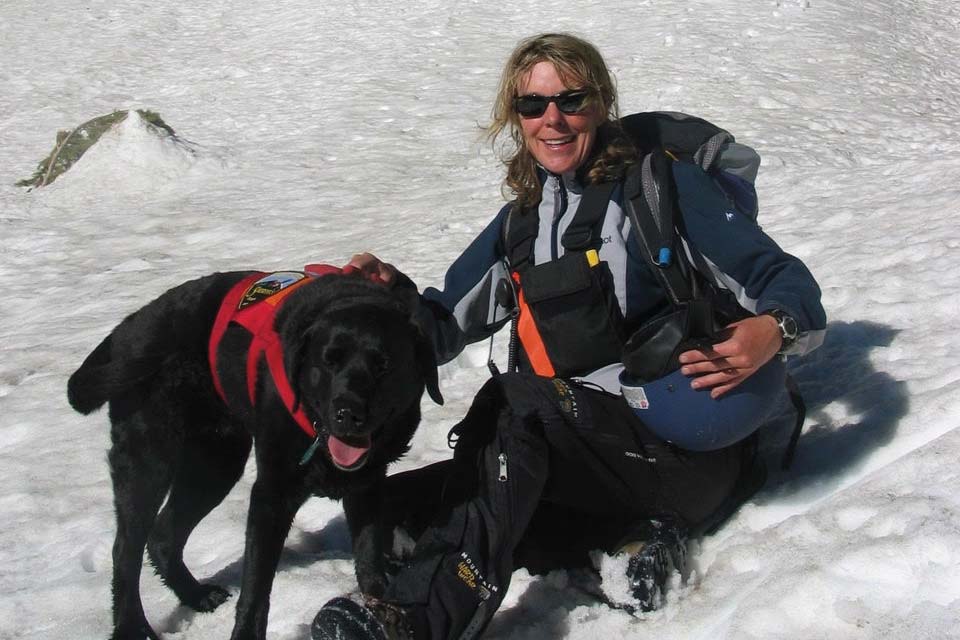By Debbie Burke
In 1995 at ski patrol school in Crested Butte, Colorado, Susan Purvis learned about the tragic death of a little boy several years before. A monstrous avalanche suddenly buried the child under 10 feet of snow.
A search dog had been on scene but didn’t find the child.
“Why not?” Susan asked. No one knew the answer—maybe poor training or a handler who didn’t know what he was doing?
That sparked a burning desire inside Susan that, until then, she didn’t know she had.
What if she could train a dog to save lives?
At the time, she worked as an exploration geologist in the Dominican Republic, spending time off skiing and rafting in Colorado. But the search for gold felt meaningless when she might find lost people instead.
Enter Tasha, a rambunctious black Lab puppy with a baby gorilla face and snowshoe feet. At an early age, Tasha already exhibited “drive,” described by dog handlers as a strong desire to hunt, search, eat, and play.
Search dogs need to be friendly to humans and other dogs. They require determination, demonstrated when they climb over obstacles and barriers to reach a favorite toy. They also must communicate with their handler and follow commands, but be independent enough to range out of sight when searching.
Determined and independent described not only Tasha’s personality but also Susan’s. Their similar temperaments made for an outstanding, tightly bonded team.
Susan had already encountered resistance as a woman in the male-dominated ski patrol and search and rescue communities. She struggled to find someone to train her and Tasha as a search team. Undeterred, she figured out ways to teach Tasha to find and retrieve hidden items. She recruited college students to play “victims” buried in snow caves.
Dogs are uniquely qualified to find missing people because their noses have 300 million olfactory receptors, compared to the human nose with only six million. Dogs take in as much sensory information with their noses as we do with our eyes.
To work effectively with Tasha, Susan studied scent science. She says, “Scent is strongest at its source but water, wind, and terrain move it in a fan shape, called the scent cone. The farther away, the weaker the scent. In the mountains, air currents stir the scent, dispersing it widely during the day. But at night, scent settles to the ground. That’s why it’s better to deploy a dog during early morning hours than at midday.”
How do dogs track a person? Humans shed “rafts,” dead skin cells mixed with bacteria, at the rate of 50,000 rafts per second. One-third fall to the ground and two-thirds rise to float in the air. Susan says, “Remember the character Pig Pen in the Peanuts comic strip, surrounded by a cloud of debris. That’s what rafts are like.”
Each individual gives off a unique scent. An important tool in search work is a scent article, like a glove, sock, or pillow case from the missing victim. After smelling the item, the dog knows to track only that person. Others may be involved in searches and the dog has to differentiate their smell from the smell of the lost person.
Rigorous training meant Tasha had to learn to ride on horseback, snowmobiles, sleds, planes, and even be lowered in a rappelling harness from a helicopter.
Susan spent thousands of dollars in training and equipment to enable her and Tasha to earn official certification in air scent, trailing, water search, avalanche, and human remains detection (HRD).
While her original intent was to save lives, Susan learned avalanche rescues more often turned into recovery missions. Her revised goal became to bring lost loved ones home to grieving families: “We vowed to never leave anyone behind and we never did.”
Susan and Tasha traveled all over Colorado to answer desperate pleas for help. Together they located remains of skiers and snowmobilers caught in avalanches, boaters who drowned, and crime victims.
In one memorable case, the killer tried to destroy a body by burning it then burying it under rock. Tasha located a small bone chip and proudly pranced around carrying it in her mouth. That was a big no-no because she’d disturbed the crime scene, but she was forgiven since she’d found the remains.
HRD requires complicated training. Dogs need enthusiastic praise, even in tragic circumstances. If a handler shows sorrow to the dog, it becomes confused about its purpose. Susan says, “When Tasha found a victim, I squealed in a happy voice and threw her favorite toy. That was hard when a grieving family might be nearby. I didn’t mean to sound disrespectful. But Tasha had to be rewarded to do her job.”
As volunteers, they didn’t even earn a cup of kibble for their efforts, often working in dangerous conditions. Their dedication brought them Congressional Recognition and they were featured in The Smithsonian and National Geographic.
On their final mission, Tasha was 10 with a graying muzzle. Nevertheless, to find a plane crash victim, they jumped from a helicopter balanced on one skid on the sheer face of 14,000-foot Whitehouse Mountain near Ouray, Colorado. Working on a massive slide area that could break loose at any moment, Tasha located the man’s remains in under an hour.
In 2005, Susan and Tasha retired from search work and moved to Whitefish, where Susan wrote her memoir about their adventures. “Go Find: My Journey to Find the Lost–And Myself,” was published in 2018 and became a bestseller.
Currently Susan works as an educator and sought-after speaker, teaching K9 training, avalanche science, and wilderness emergency medicine. Her students include search and rescue personnel, the Secret Service, Navy Seals, first responders, business executives, Sherpas, and more. CNN features her as an expert in K9 search work.
Tasha is now chasing Milk Bones on the other side of the Rainbow Bridge.
In the dedication of her book, Susan writes: “To Tasha for helping me find my way.” MSN









